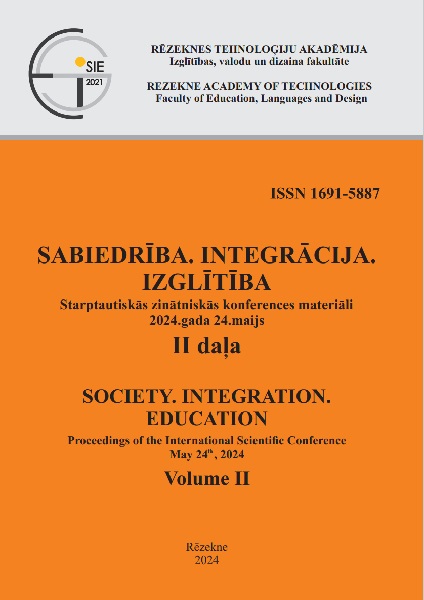ARTIFICIAL INTELLIGENCE CONTROLLED RELAXATION SYSTEM FOR AUTISTIC CHILDREN – IT TECHNOLOGY THAT ADDRESSES SOCIAL ISSUES
DOI:
https://doi.org/10.17770/sie2024vol2.7823Keywords:
artificial intelligence, autism spectrum disorder, emotion recognition, image processingAbstract
The article presents the development and research of technological tools - a relaxation system for children with autism. The article describes the means and methods of emotional stabilization of children with autism spectrum disorders. The design, operation, and control of the relaxation system controlled by artificial intelligence with image processing and machine learning are described. The relaxation effect on children is carried out with audio-musical signals, by combining them with colored light and mechanical vibration of the back area. The practical research results are described, demonstrating the system's effectiveness for children with autism spectrum disorders. Under normal conditions, if a child takes 3 to 4 hours to calm down, the relaxation system shortens this time to 10 to 15 minutes. Finally, the relaxation system controlled by artificial intelligence-based software, created by scientists from three Lithuanian universities and the students of Vilnius Kolegija, is presented as a technological tool designed to address social issues in society.
References
Alam, M. M., Khan, A. A., & Farooq, M. (2018). Effect of whole-body vibration on neuromuscular performance: A literature review. Work, 59(4), 571-583. doi:10.3233/WOR-182699
Baltrušaitis, T., Robinson, P., & Morency, L. P. (2012) 3D Constrained Local Model for Rigid and Non-Rigid Facial Tracking. In 2012 IEEE Conference on Computer Vision and Pattern Recognition, 2610-2617. doi: 10.1109/CVPR.2012.6247980.
Ben-Sasson, A., Cermak, S. A., Orsmond, G. I., Tager-Flusberg, H., Carter, A. S., Kadlec, M. B., & Dunn, W. (2007). Extreme sensory modulation behaviors in toddlers with autism spectrum disorders. The American Journal of Occupational Therapy, 61(5), 584-592. doi: https://doi.org/10.5014/ajot.61.5.584
Brondino, N., Fusar-Poli, L., Rocchetti, M., Provenzani, U., Barale, F., & Politi, P. (2015). Complementary and alternative therapies for autism spectrum disorder. Evidence-Based Complementary and Alternative Medicine, 2015. doi: 10.1155/2015/258589
Casanova, M. F. (2007). The neuropathology of autism. Brain pathology, 17(4), 422-433. doi: https://doi.org/10.1111/j.1750-3639.2007.00100.x
Dickie, V. A., Baranek, G. T., Schultz, B., Watson, L. R., & McComish, C. S. (2009). Parent reports of sensory experiences of preschool children with and without autism: A qualitative study. The American Journal of Occupational Therapy, 63(2), 172-181. doi: https://doi.org/10.5014/ajot.63.2.172
He, K., Zhang, X., Ren, S., & Sun, J. (2016). Deep residual learning for image recognition. In Proceedings of the IEEE conference on computer vision and pattern recognition. 770-778.
Retrvieted from: https://openaccess.thecvf.com/content_cvpr_2016/html/He_Deep_Residual_Learning_CVPR_2016_paper.html
Huang, M., Liao, L. R., & Pang, M. Y. (2017). Effects of whole body vibration on muscle spasticity for people with central nervous system disorders: a systematic review. Clinical rehabilitation, 31(1), 23-33. doi:10.1177/0269215515621117
Shah, S. J., Li, Z., Shah, A. M., & Ullah, R. (2018). Face ID: an innovative biometric approach to control sales personnel production deviance. International Journal of Information Systems and Change Management, 10(3), 227-247. doi: https://doi.org/10.1504/IJISCM.2018.096772
Kahou, S. E., Bouthillier, X., Lamblin, P., Gulcehre, C., Michalski, V., Konda, K., ... & Bengio, Y. (2016). Emonets: Multimodal deep learning approaches for emotion recognition in video. Journal on Multimodal User Interfaces, 10, 99-111.
Matson, J. L. (2009). Applied Behavior Analysis for Children with Autism Spectrum Disorders. New York: Springer.
Costa, A. P., Steffgen, G., Lera, F. R., Nazarikhorram, A., & Ziafati, P. (2017). Socially assistive robots for teaching emotional abilities to children with autism spectrum disorder. In 3rd Workshop on Child-Robot Interaction at HRI.
Mousavi, S. M. H., & Aghsaghloo, N. (2018) Using Visual Evolutionary Art Based On Color Patterns And Depth Assist For Autism Rehabilitation. Journal of Software Engineering Intelligent Systems, 3(3) ISSN 2518-8739
Zhang, T., Zheng, W., Cui, Z., Zong, Y., & Li, Y. (2018). Spatial–temporal recurrent neural network for emotion recognition. IEEE transactions on cybernetics, 49(3), 839-847. doi: 10.1109/TCYB.2017.2788081
Janzen, T. B., & Thaut, M. H. (2018). Rethinking the role of music in the neurodevelopment of autism spectrum disorder. Music & Science, 1. doi: https://doi.org/10.1177/2059204318769639






